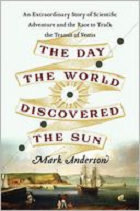
![]()
By Mark Anderson
Da Capo Press, $26.00, 280 pages
Close your eyes, and imagine a scientist. Your mental image is very likely a nerdy, white, middle-aged (or older) man in a lab coat on a university campus. From our perch at the beginning of the 21st century, it’s easy to think that this has always been the case. The Day the World Discovered the Sun describes a time when scientists were introduced to kings, and hailed as conquering heroes.
For navigators during the age of sail, no information was more necessary, or more vital to the survival of the ship and her crew, than to know the PRECISE latitude and longitude of their position. By the first half of the 18th century, astronomers realized that by observing the transit of Venus across the face of the Sun, they would be able to use simple trigonometry to create extremely accurate maps and charts. The transit of Venus occurs (at most) twice per century.
It is rare that a history book can be described as genuinely suspenseful. Anderson’s narrative is exciting; his description of three different expeditions reads like an adventure novel. He also clearly explains the math behind the astronomy, and why it’s important even today. June 5, 2012 marks the last transit of Venus in our lifetime, the next time this occurs will be in 117 years. If sometime in late spring you happen to glance towards the stars, remember that 250 years ago, you wouldn’t want to mess with a scientist.
Reviewed by Brad Wright
[amazon asin=0306820382&text=Buy On Amazon&template=carousel]
